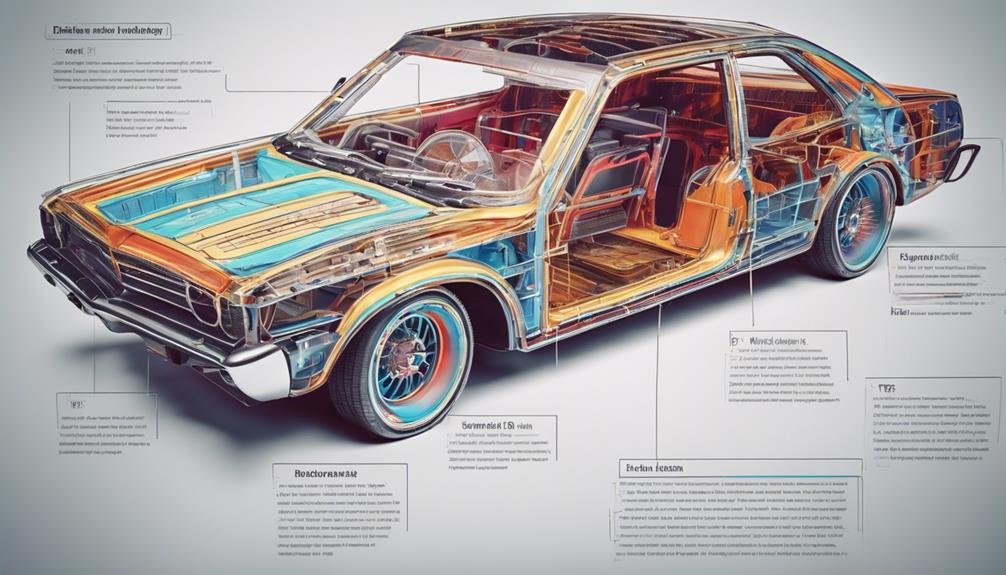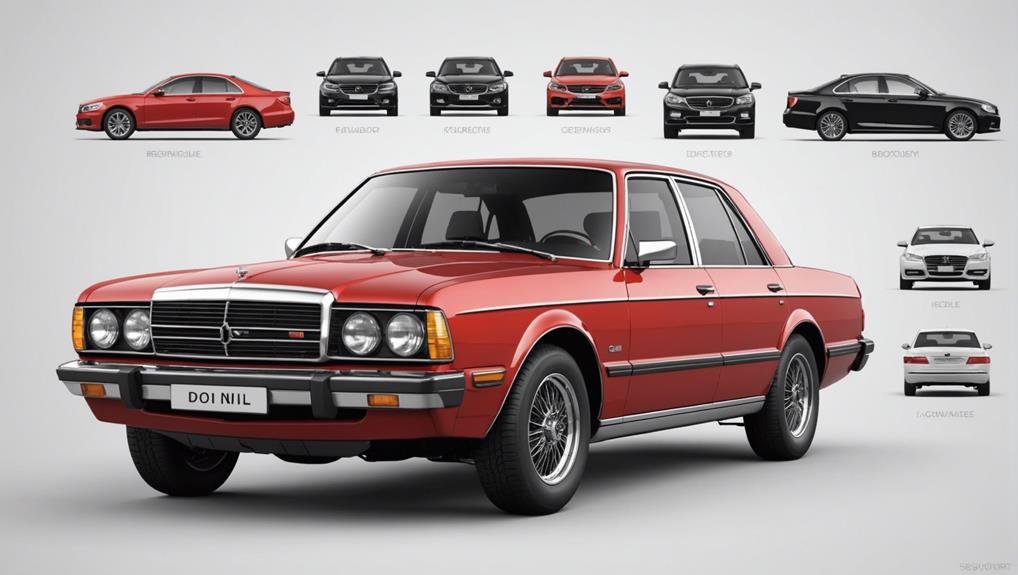As you inspect your vehicle, you're surrounded by a complex network of car body parts, each playing a critical role in protecting you, your passengers, and the vehicle itself from the rigors of the road. Bumpers absorb impacts, fenders shield from road debris, and doors provide access and egress. The roof pillars offer structural support, while components like hoods and trunk lids safeguard engine components. Body panels protect parts and passengers, absorbing and distributing impact forces. As you examine the exterior of your vehicle, you'll uncover how each part collaborates to improve your riding experience and safety – and there's more to uncover about how these components work together seamlessly.
Key Takeaways
- Bumpers absorb minor impacts, shielding the vehicle from damage and protecting passengers.
- Fenders provide protection from road debris and support the vehicle's structure.
- Doors serve as entry and exit points, while also contributing to the vehicle's overall strength.
- Hoods or bonnets cover the engine, allowing for airflow and protecting vital components.
- The roof and pillars work together to provide structural support and protection for occupants.
Car Body Diagram Explained
When you take a closer look at a car body diagram, you'll typically find that it includes a variety of essential components, including bumpers, fenders, doors, and roof pillars, all of which work together to form the outer structure of your vehicle. These components not only provide a sleek, aesthetic appeal but also serve important functions in protecting the vehicle and its occupants.
For instance, bumpers absorb impacts, while fenders shield the vehicle from road debris and maintain paint quality. Doors provide easy access and egress, while roof pillars offer structural support and protection from external elements.
Additionally, components like hoods, trunk lids, and bonnet grilles serve specific functions in safeguarding engine components and allowing air circulation in the engine bay. By understanding these components through a car body diagram, you'll gain a deeper appreciation for how they work together to form the outer structure of your vehicle, ultimately contributing to its overall safety and design.
Identifying Body Panels
You'll find that body panels, large steel sections strategically placed throughout your vehicle, protect both parts and passengers during collisions. These vital car components improve the riding experience by providing structural integrity and safety, while also contributing to the overall comfort and aesthetic appeal of your vehicle.
The evolution of body panel design has led to more comfortable and safer vehicle structures, which, in turn, minimize repair costs by safeguarding vital car components. As you inspect your vehicle, you'll notice that body panels are strategically positioned to absorb and distribute the forces of impact, thereby protecting occupants and minimizing damage.
Understanding Car Body Structure

Your car's body structure is essential and plays a vital role in providing protection, functionality, and aesthetic appeal. These components form a cohesive structure that shields you from external elements while providing a comfortable and safe driving experience.
Fenders, for instance, act as a shield, protecting your car from road debris and preventing mud from contacting your tires, thereby enhancing vehicle efficiency. Doors, on the other hand, serve as entry and exit points, integrated with side windows for visibility and security, and can be either manual or power-operated.
The roof provides protection from external elements, while pillars support the structure and provide rigidity based on the vehicle's length. Roofs and pillars play a significant role in safety and comfort, with varying designs catering to different vehicle types, such as hatchbacks.
Understanding your car's body structure is essential in appreciating its functionality and aesthetic appeal.
Exterior Car Parts Overview
Exterior car parts, including bumpers, fenders, doors, and hoods, work together to protect and improve the vehicle's appearance. These components not only improve the car's visual appeal but also provide functional benefits.
For instance, bumpers absorb impacts, fenders shield the car from road debris, and doors provide convenient entry and exit points. The hood, also known as the bonnet, covers the engine and features a grille that allows airflow while protecting the engine compartment. Moreover, the bonnet grille is typically made of lightweight yet durable materials.
At the rear of the car, you'll find the trunk, a secure storage space that contributes to safety and organization. Fenders, which are often overlooked, play an important role in shielding the car from mud splashes and road debris, thereby improving efficiency and protecting the paint.
As you examine your car's exterior, you'll appreciate the intricate design and functionality of these exterior car parts.
Car Body Components Listed

As you inspect the car's body, its different components collaborate to guarantee safety, functionality, and visual appeal, with bumpers, fenders, doors, hoods, and trunks forming a protective shield around the vehicle and its occupants. These components work together to secure a safe and comfortable driving experience.
The roof and pillars provide structural support and protection from external elements, enhancing the vehicle's safety and rigidity. Fenders shield the car from road debris, preventing mud and dirt from contacting the tires and minimizing paint scratches. Doors serve as entry and exit points for passengers, integrating side windows for visibility and security in modern vehicles.
The windshield acts as a shield against wind and debris, featuring UV protection and laminated safety glass for occupant safety. Moreover, bumpers, hoods, and trunks work together to protect the vehicle and its occupants during collisions. By understanding these components, you can appreciate the complexity and importance of a car's body in ensuring a safe and enjoyable driving experience.
Body Parts and Functions
When you examine the car's body more closely, you'll realize that each part plays a vital role in safeguarding both the vehicle and its occupants. The body parts, including bumpers, fenders, and doors, provide structural support, enhancing the integrity of the vehicle.
Furthermore, these body panels absorb impact energy during collisions, ensuring passenger safety. The roof and pillars contribute to the structural rigidity of the vehicle, protecting occupants from external elements.
Furthermore, the trunk serves as a secure storage space for luggage, enhancing safety and weight distribution. Fenders, another essential body part, shield the car from road debris, prevent mud contact with tires, and improve overall vehicle efficiency.
Exterior Body Parts Identified

Your car's exterior is made up of several key components, including bumpers, fenders, doors, and hood/bonnet, all working together to protect and style your vehicle. These exterior body parts serve both functional and aesthetic purposes.
The front and rear bumpers, for instance, absorb minor impacts, while the fenders provide additional protection and support. Your car's doors, of course, allow easy entry and exit, and the hood/bonnet shields the engine from the elements.
The trunk, located at the rear, provides secure storage space for luggage and contributes to your vehicle's overall weight distribution. The roof and pillars offer structural rigidity and protection from external elements, ensuring a safe and comfortable ride for occupants.
Furthermore, the bonnet grille allows air to enter or exit the engine bay, protecting vital engine components. Side mirrors, mounted on the doors, improve your visibility by providing views of blind spots and surroundings.
Frequently Asked Questions
Is There an App That Can Identify Car Parts?
You're wondering if there's an app that can identify car parts? Yes, there are! Apps like Car Parts and Car Scanner use image recognition to identify components, providing details, compatibility, pricing, and purchase info.
How Do I Find the Exact Parts of My Car?
You're trying to find the exact parts of your car. Start by looking up your car's make, model, and year to get accurate info, and then utilize online resources like car part websites or forums for detailed diagrams and descriptions.
How Do I Know the Body Type of My Car?
You're wondering how to determine your car's body type, which affects its appearance, functionality, and purpose. Check your owner's manual or manufacturer's website, or look for badges or labels on your vehicle to find out.
How Do I Know What Parts Are Compatible With My Car?
You'll want to guarantee the right fit, so check your vehicle's make, model, and year to find compatible parts, and don't forget to use your VIN for precision in part compatibility.
Conclusion
You've now gained a thorough understanding of your vehicle's body, including its structure, panels, and components. You can identify the hood, trunk, roof, and doors, along with the bumpers, fenders, and quarter panels.
You're familiar with the role of each part, from providing structural integrity to enhancing aesthetics. With this knowledge, you'll be better equipped to diagnose issues, communicate with mechanics, and maintain your vehicle's appearance and performance.
